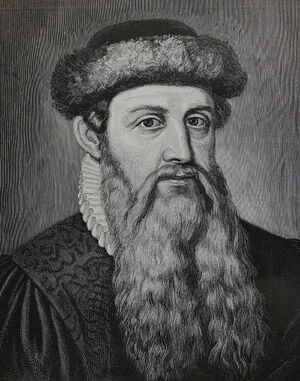Johannes Gutenberg (nonfiction): Difference between revisions
No edit summary |
No edit summary |
||
| Line 28: | Line 28: | ||
[[Category:Inventors (nonfiction)]] | [[Category:Inventors (nonfiction)]] | ||
[[Category:People (nonfiction)]] | [[Category:People (nonfiction)]] | ||
[[Category:Printers (nonfiction)]] | |||
Latest revision as of 10:35, 18 June 2017
Johannes Gensfleisch zur Laden zum Gutenberg (/joʊˌhɑːnᵻs ˈɡuːtənbɛərɡ/ yoh-hah-nəs goo-tən-behrg; c. 1398 – February 3, 1468) was a German blacksmith, goldsmith, printer, and publisher who introduced printing to Europe.
His introduction of mechanical movable type printing to Europe started the Printing Revolution and is widely regarded as the most important invention of the second millennium, the seminal event which ushered in the modern period of human history.
Mechanical movable type played a key role in the development of the Renaissance, Reformation, the Age of Enlightenment, and the scientific revolution and laid the material basis for the modern knowledge-based economy and the spread of learning to the masses.
Gutenberg in 1439 was the first European to use the printing press and movable type in Europe. Among his many contributions to printing are: the invention of a process for mass-producing movable type;[citation needed] the use of oil-based ink for printing books; adjustable molds; mechanical movable type; and the use of a wooden printing press similar to the agricultural screw presses of the period.
His truly epochal invention was the combination of these elements into a practical system that allowed the mass production of printed books and was economically viable for printers and readers alike.
In the News
Fiction cross-reference
Nonfiction cross-reference
External links:
- Johannes Gutenberg @ Wikipedia
